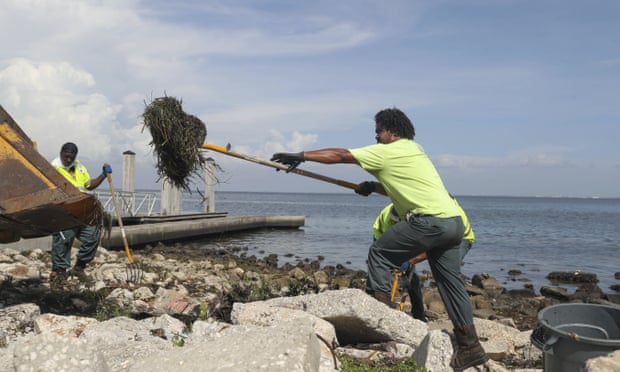Piles of dead fish, dolphins, turtles and manatees are rotting on the shorelines of coastal Florida in a soup of reddish brown ocean water after a devastating so-called “red tide” algal bloom struck sea life in the region.
The city council in St Petersburg, Florida, called for a state of emergency last week saying that crews need help getting the dead sea creatures cleaned up from the beaches. In the Pinellas county area, more than 800 tons of dead fish and sea life have washed ashore – and the smell is already hitting the cities.
Red tides do happen in the area, but this year’s incident is so serious that it is causing some experts to wonder if a pollution accident at a former fertilizer plant called Piney Point could be a reason it is so bad.
In March, a dam at a reservoir at the defunct plant that stored phosphate wastewater began to fail, prompting temporary evacuations of nearby residents on 1 April. Two days later, Florida’s governor, Ron DeSantis, issued a state of emergency. The plant released 215m gallons of contaminated water into Tampa Bay in an effort to prevent the reservoir’s collapse.
The current algal bloom can be traced back to December 2020, when it began to travel north up the coast into the Tampa Bay area. Tropical storm Elsa also caused strong winds, which may be pushing fish to pile up on shores in much larger and stinkier quantities.
Even though the bloom already existed before the spill, the extra nutrients from the Piney Point spill created a cascading situation that rapidly became worse and boosted the algal bloom. Robert Weisberg, a professor at the University of South Florida, told local news stations he believed Piney Point discharges could be fueling that same bloom and making matters worse. “I don’t think it would’ve taken off to the levels that we’re seeing without Piney Point,” Weisberg explained.
Tom Frazer, now the dean and a professor at the University of South Florida College of Marine Science, said during a discussion hosted by DeSantis that nutrients from the Piney Point phosphate-plant site could be helping fuel the outbreak.
“I don’t think that the red tide was originated as a consequence of Piney Point,” Frazer said during the discussion at the Fish and Wildlife Research Institute in St Petersburg. “One of the things that we saw with the red tide early on was that it was south of the discharge area, with the red tide continuing to kind of migrate or move northward into lower Tampa Bay.
“It’s quite possible that nutrients, recycled nutrients in the system as a result of Piney Point could have contributed to that. But there are a large number of nutrient sources along the coast. And, again, we’ve tried to address a lot of those nutrient sources.”
Red tide is a higher-than-normal concentration of a microscopic plantlike organism. In Florida and the Gulf of Mexico, the species that causes most red tides is Karenia brevis. Red tides were recorded in this area as far back as the 1700s and along Florida’s Gulf coast in the 1840s. It can cause respiratory problems for people, kill fish and other marine life, and cause shellfish poisoning in people.
Blooms usually start in the fall and go away by January, but summer blooms in the area have occurred a handful of times in more recent history: 1995, 2005 and, most recently, 2018. That year, a long-lasting red tide bloom killed sea life as large as manatees and dolphins, caused widespread health effects and drove tourists away from beaches.
St Petersburg city officials have said the carnage this year is worse than 2018. “Tampa Bay is really sick right now, really extraordinarily bad. Conditions that we haven’t seen in decades,” said Justin Bloom, a board member for the environmental groups Tampa Bay and Suncoast Waterkeeper.
This weekend, locals concerned about red tide will march in St Petersburg to demand increased protections of waterways. They are asking that Florida’s governor declare a state of emergency, as well as demanding a plan for Florida to end phosphate mining in Florida.
“Failure to enact policies that protect the environment and long-term climate denial have created the current disaster in Tampa Bay,” said a statement by the protest’s organizers. “The Tampa Bay community is demanding that our state leaders declare the current red tide crisis a state of emergency.”






